Theories of Organizational Management: A Critical Essay Analysis
VerifiedAdded on 2020/04/01
|7
|1902
|67
Essay
AI Summary
This essay critically analyzes various organizational management theories, emphasizing the contingency theory which posits that there is no single best way to manage. It explores how effective management is dependent on factors such as organizational size, employee competence, and cultural orientation. The essay discusses the evolution from classical management theories to modern approaches, highlighting the importance of adapting leadership styles to suit different organizational contexts. It examines various leadership styles, including directive, authoritative, participative, and coaching styles, and illustrates how technology and employee development levels influence management practices. The essay underscores the dynamic nature of the business environment and stresses the need for managers to modify their approaches to align with the specific needs of their employees and the organization's goals. The essay references key management theorists and concludes that successful organizations require flexible management practices.
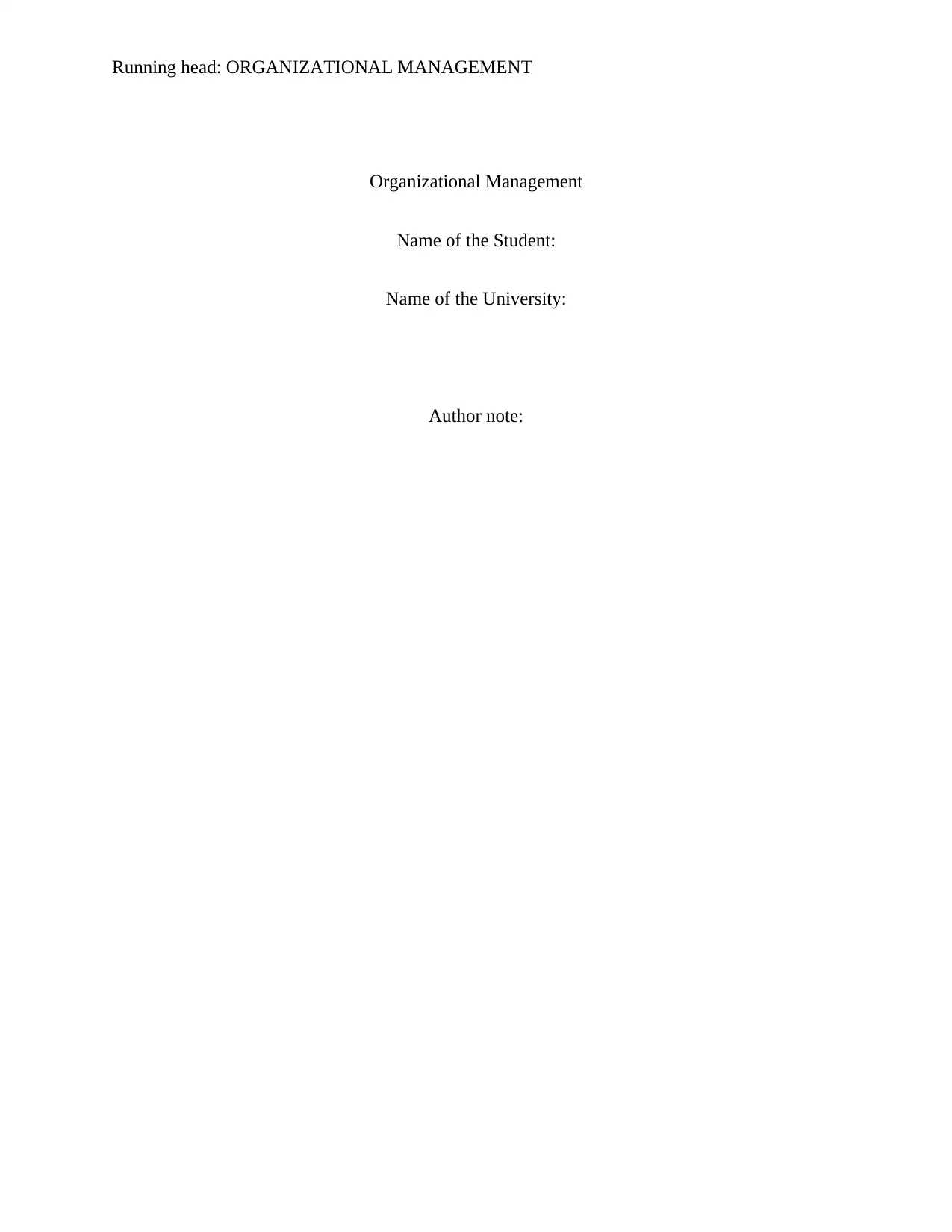
Running head: ORGANIZATIONAL MANAGEMENT
Organizational Management
Name of the Student:
Name of the University:
Author note:
Organizational Management
Name of the Student:
Name of the University:
Author note:
Paraphrase This Document
Need a fresh take? Get an instant paraphrase of this document with our AI Paraphraser
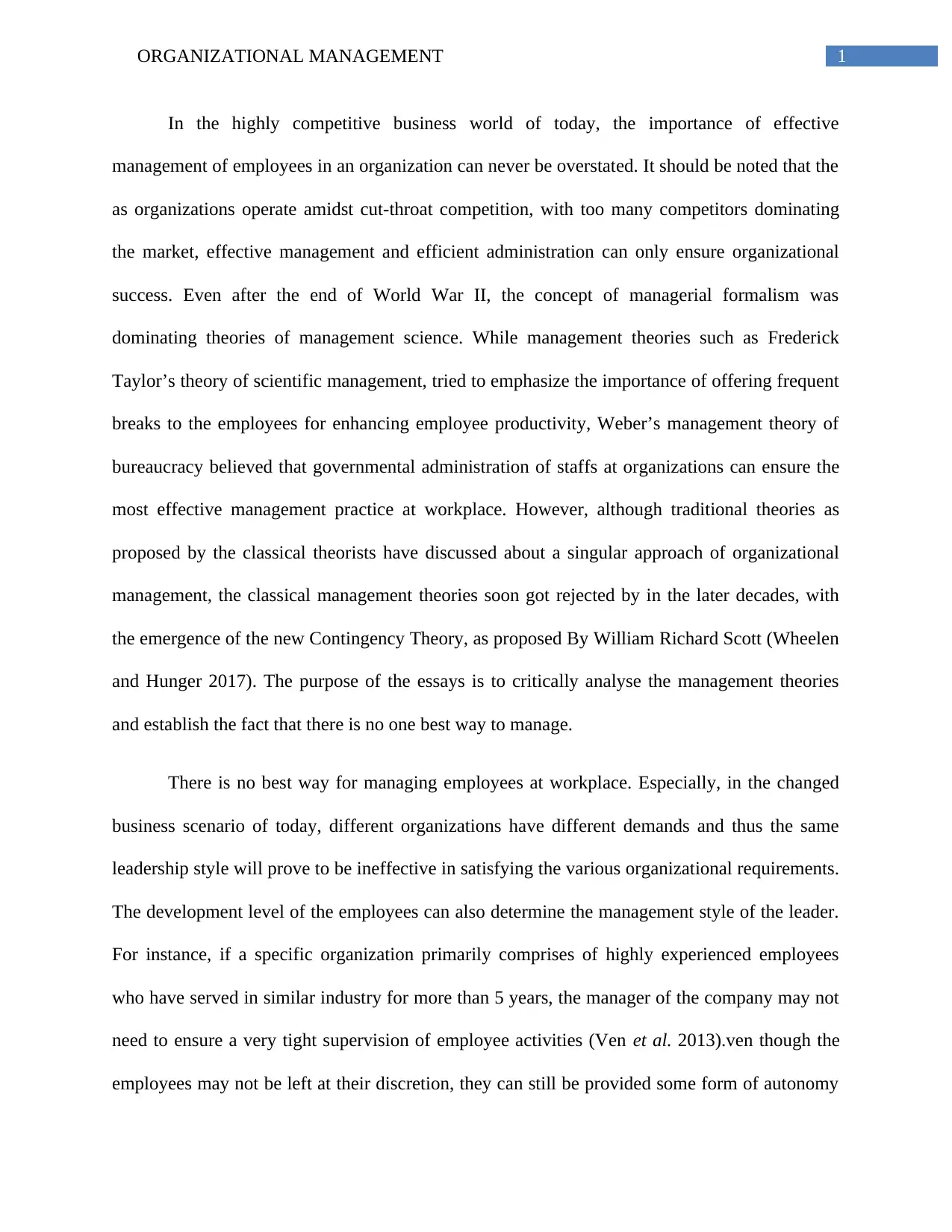
1ORGANIZATIONAL MANAGEMENT
In the highly competitive business world of today, the importance of effective
management of employees in an organization can never be overstated. It should be noted that the
as organizations operate amidst cut-throat competition, with too many competitors dominating
the market, effective management and efficient administration can only ensure organizational
success. Even after the end of World War II, the concept of managerial formalism was
dominating theories of management science. While management theories such as Frederick
Taylor’s theory of scientific management, tried to emphasize the importance of offering frequent
breaks to the employees for enhancing employee productivity, Weber’s management theory of
bureaucracy believed that governmental administration of staffs at organizations can ensure the
most effective management practice at workplace. However, although traditional theories as
proposed by the classical theorists have discussed about a singular approach of organizational
management, the classical management theories soon got rejected by in the later decades, with
the emergence of the new Contingency Theory, as proposed By William Richard Scott (Wheelen
and Hunger 2017). The purpose of the essays is to critically analyse the management theories
and establish the fact that there is no one best way to manage.
There is no best way for managing employees at workplace. Especially, in the changed
business scenario of today, different organizations have different demands and thus the same
leadership style will prove to be ineffective in satisfying the various organizational requirements.
The development level of the employees can also determine the management style of the leader.
For instance, if a specific organization primarily comprises of highly experienced employees
who have served in similar industry for more than 5 years, the manager of the company may not
need to ensure a very tight supervision of employee activities (Ven et al. 2013).ven though the
employees may not be left at their discretion, they can still be provided some form of autonomy
In the highly competitive business world of today, the importance of effective
management of employees in an organization can never be overstated. It should be noted that the
as organizations operate amidst cut-throat competition, with too many competitors dominating
the market, effective management and efficient administration can only ensure organizational
success. Even after the end of World War II, the concept of managerial formalism was
dominating theories of management science. While management theories such as Frederick
Taylor’s theory of scientific management, tried to emphasize the importance of offering frequent
breaks to the employees for enhancing employee productivity, Weber’s management theory of
bureaucracy believed that governmental administration of staffs at organizations can ensure the
most effective management practice at workplace. However, although traditional theories as
proposed by the classical theorists have discussed about a singular approach of organizational
management, the classical management theories soon got rejected by in the later decades, with
the emergence of the new Contingency Theory, as proposed By William Richard Scott (Wheelen
and Hunger 2017). The purpose of the essays is to critically analyse the management theories
and establish the fact that there is no one best way to manage.
There is no best way for managing employees at workplace. Especially, in the changed
business scenario of today, different organizations have different demands and thus the same
leadership style will prove to be ineffective in satisfying the various organizational requirements.
The development level of the employees can also determine the management style of the leader.
For instance, if a specific organization primarily comprises of highly experienced employees
who have served in similar industry for more than 5 years, the manager of the company may not
need to ensure a very tight supervision of employee activities (Ven et al. 2013).ven though the
employees may not be left at their discretion, they can still be provided some form of autonomy
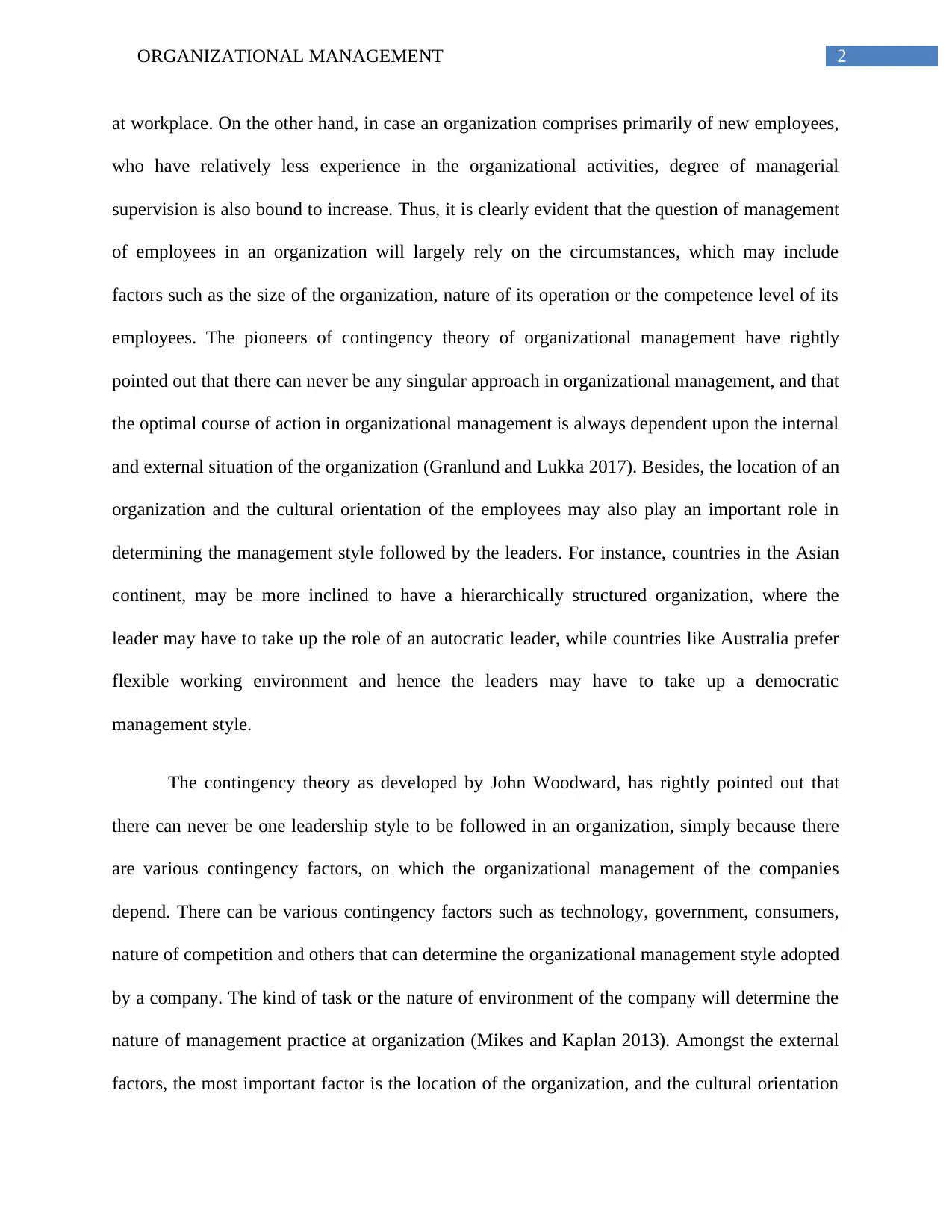
2ORGANIZATIONAL MANAGEMENT
at workplace. On the other hand, in case an organization comprises primarily of new employees,
who have relatively less experience in the organizational activities, degree of managerial
supervision is also bound to increase. Thus, it is clearly evident that the question of management
of employees in an organization will largely rely on the circumstances, which may include
factors such as the size of the organization, nature of its operation or the competence level of its
employees. The pioneers of contingency theory of organizational management have rightly
pointed out that there can never be any singular approach in organizational management, and that
the optimal course of action in organizational management is always dependent upon the internal
and external situation of the organization (Granlund and Lukka 2017). Besides, the location of an
organization and the cultural orientation of the employees may also play an important role in
determining the management style followed by the leaders. For instance, countries in the Asian
continent, may be more inclined to have a hierarchically structured organization, where the
leader may have to take up the role of an autocratic leader, while countries like Australia prefer
flexible working environment and hence the leaders may have to take up a democratic
management style.
The contingency theory as developed by John Woodward, has rightly pointed out that
there can never be one leadership style to be followed in an organization, simply because there
are various contingency factors, on which the organizational management of the companies
depend. There can be various contingency factors such as technology, government, consumers,
nature of competition and others that can determine the organizational management style adopted
by a company. The kind of task or the nature of environment of the company will determine the
nature of management practice at organization (Mikes and Kaplan 2013). Amongst the external
factors, the most important factor is the location of the organization, and the cultural orientation
at workplace. On the other hand, in case an organization comprises primarily of new employees,
who have relatively less experience in the organizational activities, degree of managerial
supervision is also bound to increase. Thus, it is clearly evident that the question of management
of employees in an organization will largely rely on the circumstances, which may include
factors such as the size of the organization, nature of its operation or the competence level of its
employees. The pioneers of contingency theory of organizational management have rightly
pointed out that there can never be any singular approach in organizational management, and that
the optimal course of action in organizational management is always dependent upon the internal
and external situation of the organization (Granlund and Lukka 2017). Besides, the location of an
organization and the cultural orientation of the employees may also play an important role in
determining the management style followed by the leaders. For instance, countries in the Asian
continent, may be more inclined to have a hierarchically structured organization, where the
leader may have to take up the role of an autocratic leader, while countries like Australia prefer
flexible working environment and hence the leaders may have to take up a democratic
management style.
The contingency theory as developed by John Woodward, has rightly pointed out that
there can never be one leadership style to be followed in an organization, simply because there
are various contingency factors, on which the organizational management of the companies
depend. There can be various contingency factors such as technology, government, consumers,
nature of competition and others that can determine the organizational management style adopted
by a company. The kind of task or the nature of environment of the company will determine the
nature of management practice at organization (Mikes and Kaplan 2013). Amongst the external
factors, the most important factor is the location of the organization, and the cultural orientation
⊘ This is a preview!⊘
Do you want full access?
Subscribe today to unlock all pages.

Trusted by 1+ million students worldwide
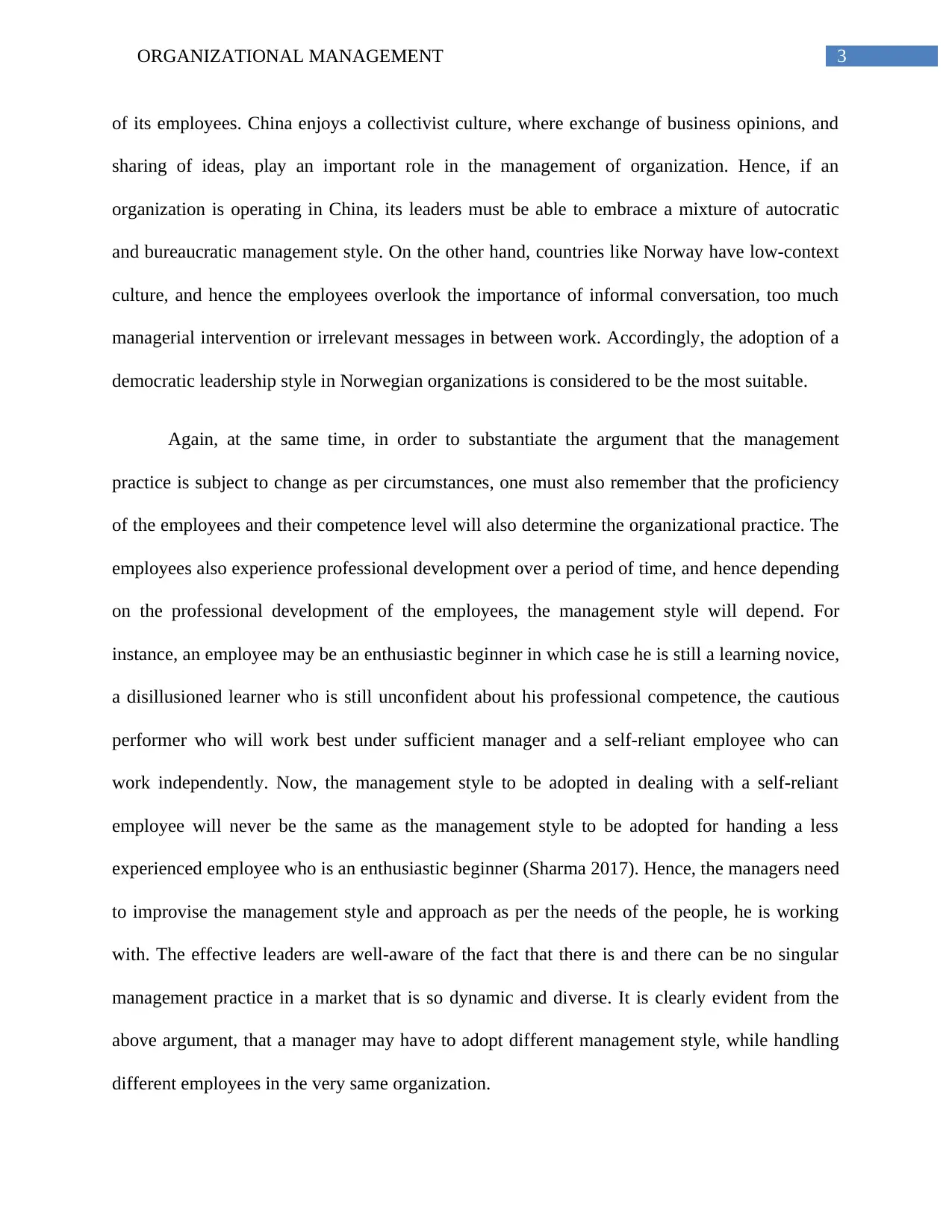
3ORGANIZATIONAL MANAGEMENT
of its employees. China enjoys a collectivist culture, where exchange of business opinions, and
sharing of ideas, play an important role in the management of organization. Hence, if an
organization is operating in China, its leaders must be able to embrace a mixture of autocratic
and bureaucratic management style. On the other hand, countries like Norway have low-context
culture, and hence the employees overlook the importance of informal conversation, too much
managerial intervention or irrelevant messages in between work. Accordingly, the adoption of a
democratic leadership style in Norwegian organizations is considered to be the most suitable.
Again, at the same time, in order to substantiate the argument that the management
practice is subject to change as per circumstances, one must also remember that the proficiency
of the employees and their competence level will also determine the organizational practice. The
employees also experience professional development over a period of time, and hence depending
on the professional development of the employees, the management style will depend. For
instance, an employee may be an enthusiastic beginner in which case he is still a learning novice,
a disillusioned learner who is still unconfident about his professional competence, the cautious
performer who will work best under sufficient manager and a self-reliant employee who can
work independently. Now, the management style to be adopted in dealing with a self-reliant
employee will never be the same as the management style to be adopted for handing a less
experienced employee who is an enthusiastic beginner (Sharma 2017). Hence, the managers need
to improvise the management style and approach as per the needs of the people, he is working
with. The effective leaders are well-aware of the fact that there is and there can be no singular
management practice in a market that is so dynamic and diverse. It is clearly evident from the
above argument, that a manager may have to adopt different management style, while handling
different employees in the very same organization.
of its employees. China enjoys a collectivist culture, where exchange of business opinions, and
sharing of ideas, play an important role in the management of organization. Hence, if an
organization is operating in China, its leaders must be able to embrace a mixture of autocratic
and bureaucratic management style. On the other hand, countries like Norway have low-context
culture, and hence the employees overlook the importance of informal conversation, too much
managerial intervention or irrelevant messages in between work. Accordingly, the adoption of a
democratic leadership style in Norwegian organizations is considered to be the most suitable.
Again, at the same time, in order to substantiate the argument that the management
practice is subject to change as per circumstances, one must also remember that the proficiency
of the employees and their competence level will also determine the organizational practice. The
employees also experience professional development over a period of time, and hence depending
on the professional development of the employees, the management style will depend. For
instance, an employee may be an enthusiastic beginner in which case he is still a learning novice,
a disillusioned learner who is still unconfident about his professional competence, the cautious
performer who will work best under sufficient manager and a self-reliant employee who can
work independently. Now, the management style to be adopted in dealing with a self-reliant
employee will never be the same as the management style to be adopted for handing a less
experienced employee who is an enthusiastic beginner (Sharma 2017). Hence, the managers need
to improvise the management style and approach as per the needs of the people, he is working
with. The effective leaders are well-aware of the fact that there is and there can be no singular
management practice in a market that is so dynamic and diverse. It is clearly evident from the
above argument, that a manager may have to adopt different management style, while handling
different employees in the very same organization.
Paraphrase This Document
Need a fresh take? Get an instant paraphrase of this document with our AI Paraphraser
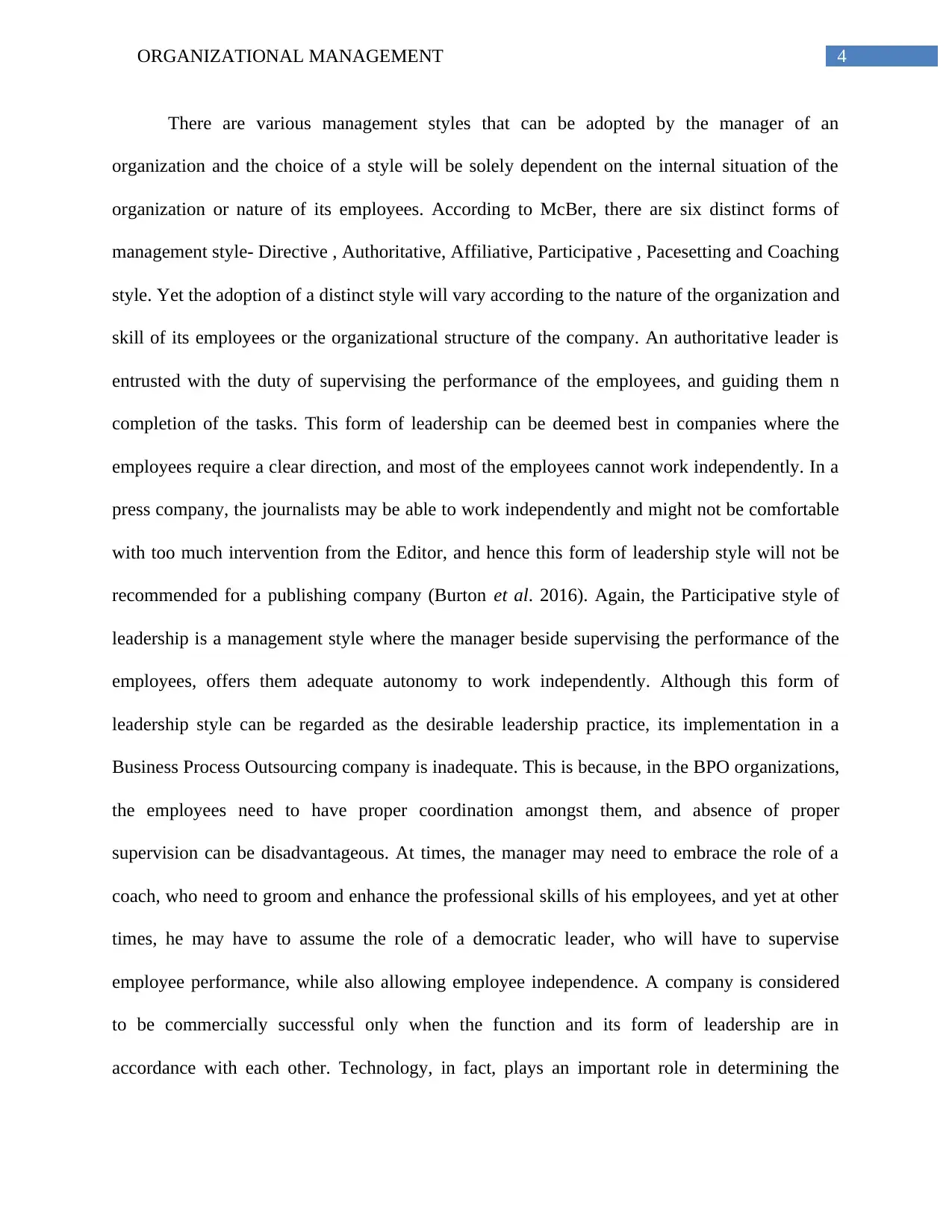
4ORGANIZATIONAL MANAGEMENT
There are various management styles that can be adopted by the manager of an
organization and the choice of a style will be solely dependent on the internal situation of the
organization or nature of its employees. According to McBer, there are six distinct forms of
management style- Directive , Authoritative, Affiliative, Participative , Pacesetting and Coaching
style. Yet the adoption of a distinct style will vary according to the nature of the organization and
skill of its employees or the organizational structure of the company. An authoritative leader is
entrusted with the duty of supervising the performance of the employees, and guiding them n
completion of the tasks. This form of leadership can be deemed best in companies where the
employees require a clear direction, and most of the employees cannot work independently. In a
press company, the journalists may be able to work independently and might not be comfortable
with too much intervention from the Editor, and hence this form of leadership style will not be
recommended for a publishing company (Burton et al. 2016). Again, the Participative style of
leadership is a management style where the manager beside supervising the performance of the
employees, offers them adequate autonomy to work independently. Although this form of
leadership style can be regarded as the desirable leadership practice, its implementation in a
Business Process Outsourcing company is inadequate. This is because, in the BPO organizations,
the employees need to have proper coordination amongst them, and absence of proper
supervision can be disadvantageous. At times, the manager may need to embrace the role of a
coach, who need to groom and enhance the professional skills of his employees, and yet at other
times, he may have to assume the role of a democratic leader, who will have to supervise
employee performance, while also allowing employee independence. A company is considered
to be commercially successful only when the function and its form of leadership are in
accordance with each other. Technology, in fact, plays an important role in determining the
There are various management styles that can be adopted by the manager of an
organization and the choice of a style will be solely dependent on the internal situation of the
organization or nature of its employees. According to McBer, there are six distinct forms of
management style- Directive , Authoritative, Affiliative, Participative , Pacesetting and Coaching
style. Yet the adoption of a distinct style will vary according to the nature of the organization and
skill of its employees or the organizational structure of the company. An authoritative leader is
entrusted with the duty of supervising the performance of the employees, and guiding them n
completion of the tasks. This form of leadership can be deemed best in companies where the
employees require a clear direction, and most of the employees cannot work independently. In a
press company, the journalists may be able to work independently and might not be comfortable
with too much intervention from the Editor, and hence this form of leadership style will not be
recommended for a publishing company (Burton et al. 2016). Again, the Participative style of
leadership is a management style where the manager beside supervising the performance of the
employees, offers them adequate autonomy to work independently. Although this form of
leadership style can be regarded as the desirable leadership practice, its implementation in a
Business Process Outsourcing company is inadequate. This is because, in the BPO organizations,
the employees need to have proper coordination amongst them, and absence of proper
supervision can be disadvantageous. At times, the manager may need to embrace the role of a
coach, who need to groom and enhance the professional skills of his employees, and yet at other
times, he may have to assume the role of a democratic leader, who will have to supervise
employee performance, while also allowing employee independence. A company is considered
to be commercially successful only when the function and its form of leadership are in
accordance with each other. Technology, in fact, plays an important role in determining the
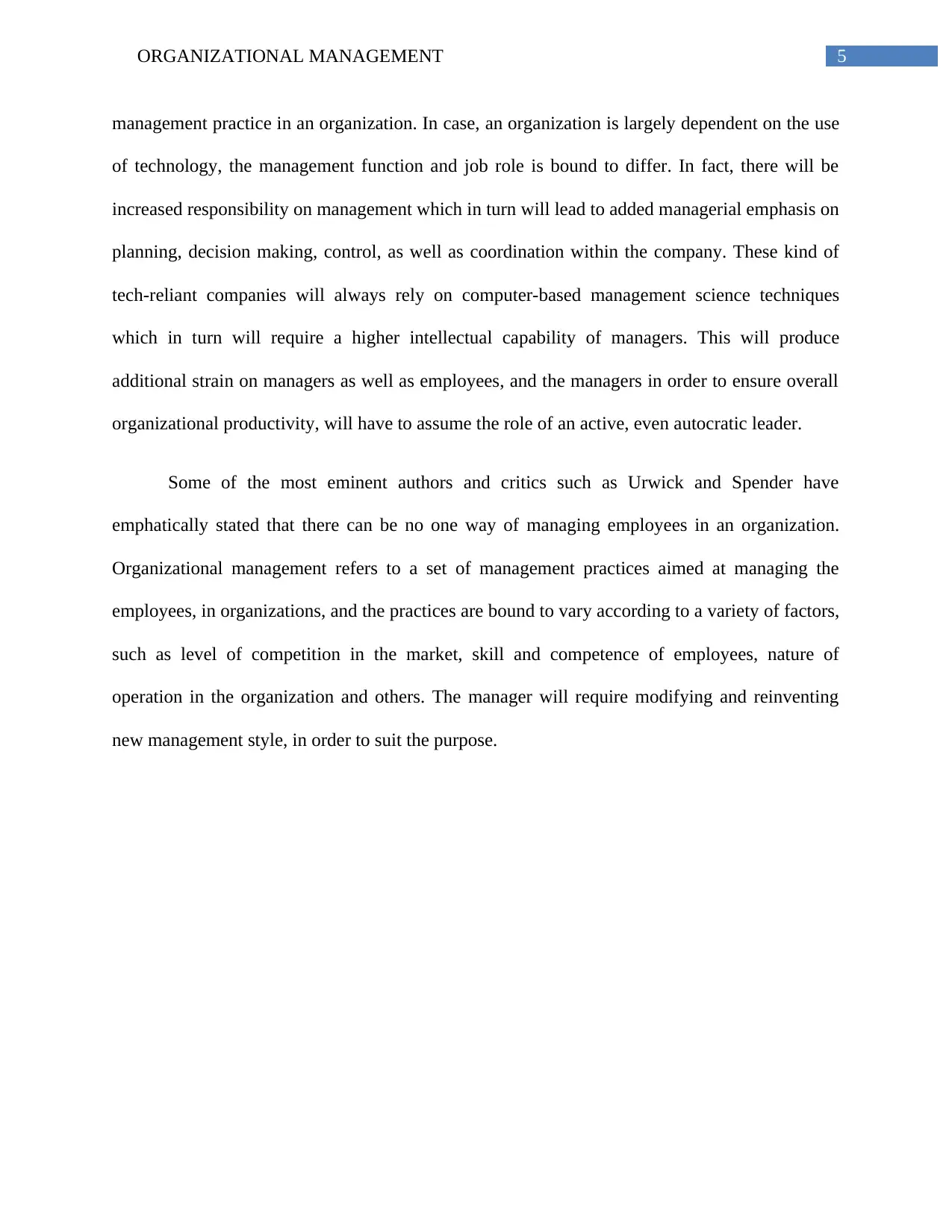
5ORGANIZATIONAL MANAGEMENT
management practice in an organization. In case, an organization is largely dependent on the use
of technology, the management function and job role is bound to differ. In fact, there will be
increased responsibility on management which in turn will lead to added managerial emphasis on
planning, decision making, control, as well as coordination within the company. These kind of
tech-reliant companies will always rely on computer-based management science techniques
which in turn will require a higher intellectual capability of managers. This will produce
additional strain on managers as well as employees, and the managers in order to ensure overall
organizational productivity, will have to assume the role of an active, even autocratic leader.
Some of the most eminent authors and critics such as Urwick and Spender have
emphatically stated that there can be no one way of managing employees in an organization.
Organizational management refers to a set of management practices aimed at managing the
employees, in organizations, and the practices are bound to vary according to a variety of factors,
such as level of competition in the market, skill and competence of employees, nature of
operation in the organization and others. The manager will require modifying and reinventing
new management style, in order to suit the purpose.
management practice in an organization. In case, an organization is largely dependent on the use
of technology, the management function and job role is bound to differ. In fact, there will be
increased responsibility on management which in turn will lead to added managerial emphasis on
planning, decision making, control, as well as coordination within the company. These kind of
tech-reliant companies will always rely on computer-based management science techniques
which in turn will require a higher intellectual capability of managers. This will produce
additional strain on managers as well as employees, and the managers in order to ensure overall
organizational productivity, will have to assume the role of an active, even autocratic leader.
Some of the most eminent authors and critics such as Urwick and Spender have
emphatically stated that there can be no one way of managing employees in an organization.
Organizational management refers to a set of management practices aimed at managing the
employees, in organizations, and the practices are bound to vary according to a variety of factors,
such as level of competition in the market, skill and competence of employees, nature of
operation in the organization and others. The manager will require modifying and reinventing
new management style, in order to suit the purpose.
⊘ This is a preview!⊘
Do you want full access?
Subscribe today to unlock all pages.

Trusted by 1+ million students worldwide
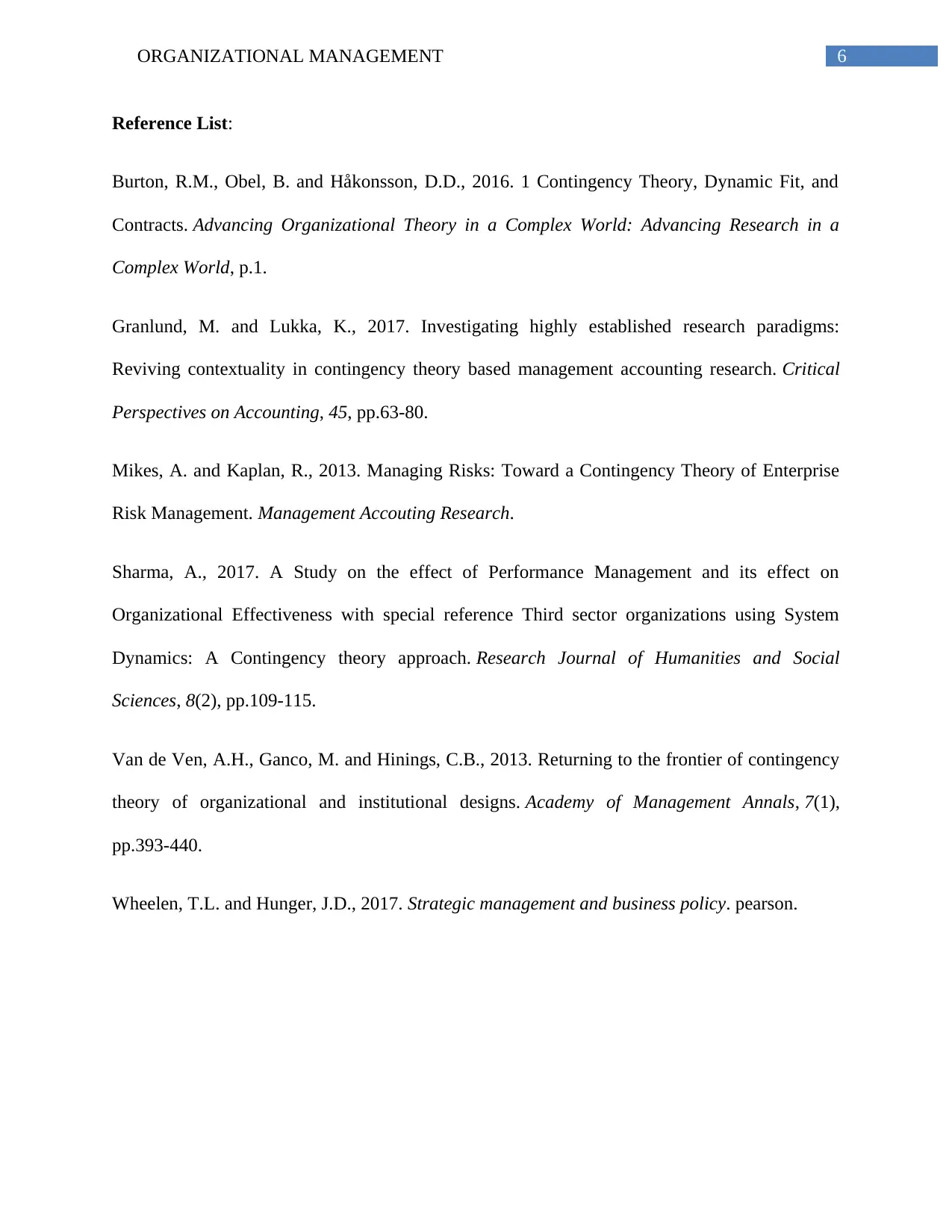
6ORGANIZATIONAL MANAGEMENT
Reference List:
Burton, R.M., Obel, B. and Håkonsson, D.D., 2016. 1 Contingency Theory, Dynamic Fit, and
Contracts. Advancing Organizational Theory in a Complex World: Advancing Research in a
Complex World, p.1.
Granlund, M. and Lukka, K., 2017. Investigating highly established research paradigms:
Reviving contextuality in contingency theory based management accounting research. Critical
Perspectives on Accounting, 45, pp.63-80.
Mikes, A. and Kaplan, R., 2013. Managing Risks: Toward a Contingency Theory of Enterprise
Risk Management. Management Accouting Research.
Sharma, A., 2017. A Study on the effect of Performance Management and its effect on
Organizational Effectiveness with special reference Third sector organizations using System
Dynamics: A Contingency theory approach. Research Journal of Humanities and Social
Sciences, 8(2), pp.109-115.
Van de Ven, A.H., Ganco, M. and Hinings, C.B., 2013. Returning to the frontier of contingency
theory of organizational and institutional designs. Academy of Management Annals, 7(1),
pp.393-440.
Wheelen, T.L. and Hunger, J.D., 2017. Strategic management and business policy. pearson.
Reference List:
Burton, R.M., Obel, B. and Håkonsson, D.D., 2016. 1 Contingency Theory, Dynamic Fit, and
Contracts. Advancing Organizational Theory in a Complex World: Advancing Research in a
Complex World, p.1.
Granlund, M. and Lukka, K., 2017. Investigating highly established research paradigms:
Reviving contextuality in contingency theory based management accounting research. Critical
Perspectives on Accounting, 45, pp.63-80.
Mikes, A. and Kaplan, R., 2013. Managing Risks: Toward a Contingency Theory of Enterprise
Risk Management. Management Accouting Research.
Sharma, A., 2017. A Study on the effect of Performance Management and its effect on
Organizational Effectiveness with special reference Third sector organizations using System
Dynamics: A Contingency theory approach. Research Journal of Humanities and Social
Sciences, 8(2), pp.109-115.
Van de Ven, A.H., Ganco, M. and Hinings, C.B., 2013. Returning to the frontier of contingency
theory of organizational and institutional designs. Academy of Management Annals, 7(1),
pp.393-440.
Wheelen, T.L. and Hunger, J.D., 2017. Strategic management and business policy. pearson.
1 out of 7
Related Documents
Your All-in-One AI-Powered Toolkit for Academic Success.
+13062052269
info@desklib.com
Available 24*7 on WhatsApp / Email
![[object Object]](/_next/static/media/star-bottom.7253800d.svg)
Unlock your academic potential
Copyright © 2020–2025 A2Z Services. All Rights Reserved. Developed and managed by ZUCOL.





